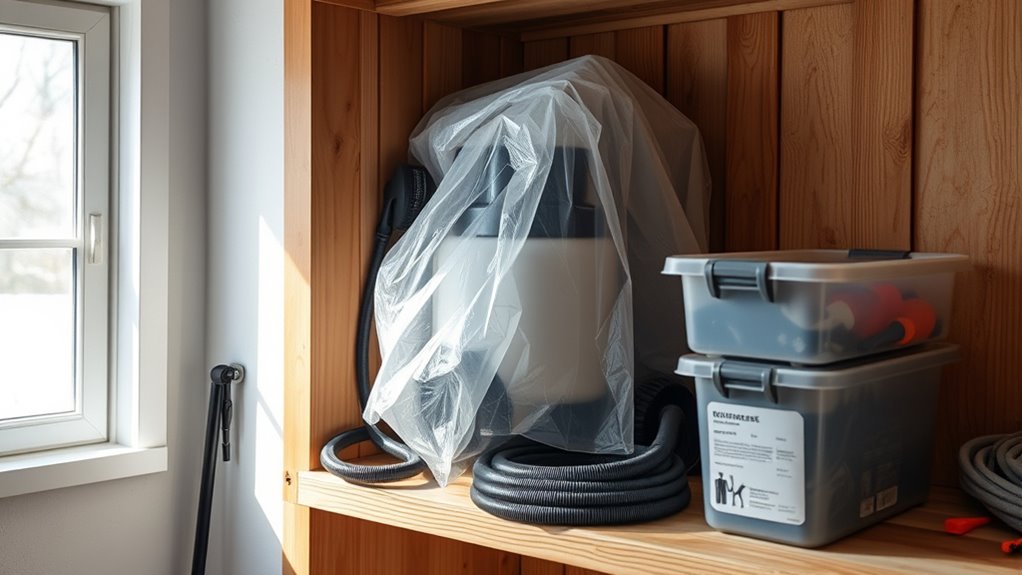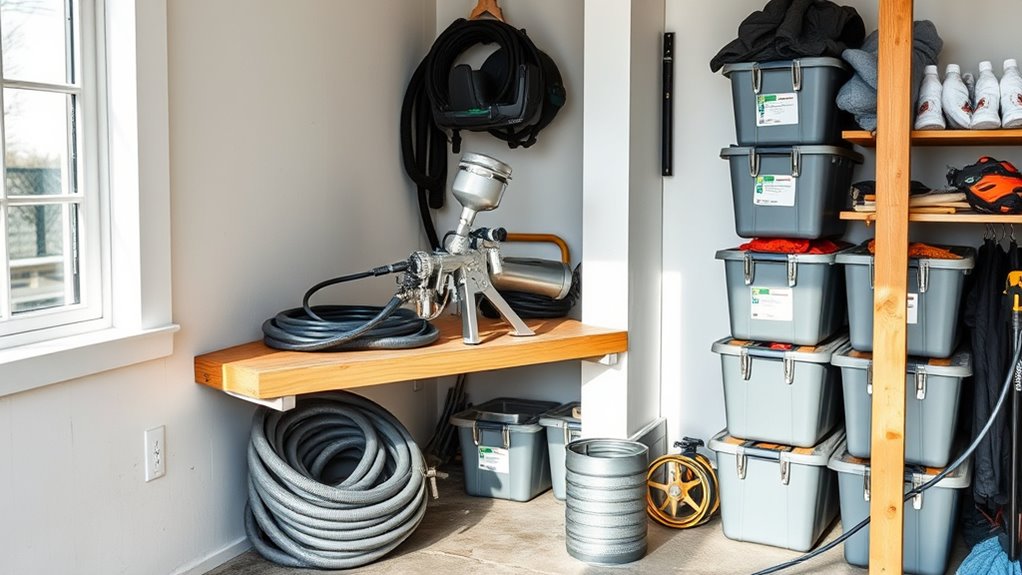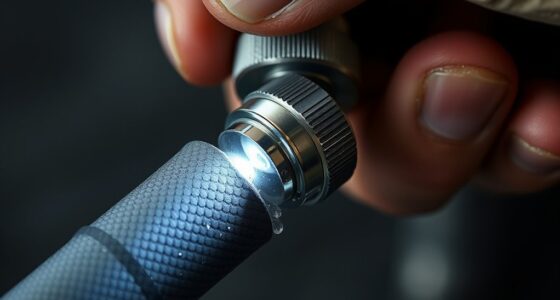To store your airless sprayer for winter, first disconnect it from power and flush out any remaining paint or cleaning solutions to prevent hardening. Drain water from hoses, apply antifreeze if needed, and thoroughly clean all components. Store it in a dry, frost-free location and cover it to protect from dust. Lubricate moving parts and inspect for damage. Following these steps helps prevent freezing and corrosion—if you want to learn more about proper winter storage, keep going.
Key Takeaways
- Thoroughly clean and flush the sprayer to remove paint and debris before storage.
- Drain all water from hoses and fittings, and apply antifreeze or pump protector if freezing temperatures are expected.
- Store the sprayer in a dry, frost-free indoor location, protected from dirt and temperature fluctuations.
- Lubricate moving parts and inspect for wear or damage, replacing parts as necessary.
- Cover the equipment to prevent dust buildup and ensure it’s ready for use in spring.

Proper storage is imperative to keep your airless sprayer in top condition and ready for future projects. When winter approaches, it’s essential to follow a thorough winterizing process to prevent damage caused by freezing temperatures and to guarantee your equipment remains in prime shape. Taking the time for proper storage and maintenance tips now will save you headaches and repair costs down the line.
Proper winterizing ensures your sprayer stays in top condition and is ready for future projects.
Start by disconnecting the sprayer from power sources and relieving any remaining pressure in the system. Empty out any leftover paint or cleaning solutions, as these substances can harden and clog your equipment if left inside during the cold months. Use the appropriate cleaning materials to flush out the paint residue thoroughly—this step is critical to avoid corrosion and buildup that could impair performance later. Once the system is clean, inspect all parts for wear or damage, replacing any worn seals, hoses, or nozzles to guarantee everything is in working order when spring arrives.
The winterizing process also involves protecting your sprayer from freezing temperatures. Apply a pump protector or antifreeze designed specifically for sprayers into the system, following the manufacturer’s instructions. This prevents water in the pump and lines from freezing and expanding, which could crack components. Be sure to drain any remaining water from the hoses and fittings before storing the equipment in a dry, frost-free location. Proper maintenance practices are essential to ensure your sprayer functions optimally when you resume use. Storing your sprayer properly is key to avoiding rust and corrosion, which can develop if moisture is allowed to settle inside.
In addition to cleaning and protecting your sprayer, consider performing some maintenance tips to keep it in excellent condition. Lubricate moving parts, such as the gun trigger and pump components, with suitable oils to prevent rust and ensure smooth operation when you start up again. Store your equipment in a clean, sheltered space, ideally indoors, where temperature fluctuations are minimal. Covering your sprayer with a tarp or dust cover can help keep dirt and debris away during the off-season.
Frequently Asked Questions
Can I Store My Airless Sprayer Outdoors During Winter?
You shouldn’t store your airless sprayer outdoors during winter. Outdoor protection isn’t enough, as freezing temperatures can damage internal components and hoses. For proper winter preparation, store your sprayer indoors in a dry, heated space. Before storage, clean and drain it thoroughly to prevent freezing and corrosion. This guarantees your equipment stays in good condition, ready for use when warmer weather arrives.
How Do I Prevent Paint From Clogging During Storage?
To prevent paint from clogging during storage, you should thoroughly clear paint residue from your sprayer. Run clean water or solvent through the system to flush out leftover paint. Additionally, clean or replace the filter to guarantee no debris causes blockages later. Proper filter cleaning and removing all paint residue keep your sprayer in good shape, preventing clogs and ensuring smooth operation when you need it again.
What Temperature Is Too Cold for Storing the Sprayer?
Think of your sprayer as a delicate flower that needs frost protection. When temperatures drop below 32°F (0°C), it’s too cold for storage, risking damage. Follow temperature guidelines to prevent freezing and cracking. Keep the sprayer in a sheltered, heated space to avoid frost forming inside. If temperatures might dip, take steps to insulate or drain the equipment, ensuring it stays safe and functional through winter’s chill.
Should I Drain All Leftover Paint Before Storage?
Yes, you should drain all leftover paint before storage. This prevents paint thinning and clogs in your sprayer. Transfer leftover paint into suitable storage containers, ensuring they’re sealed tightly. Properly draining and storing your paint helps maintain its quality and makes future use easier. Also, clean the sprayer thoroughly to prevent dried paint from causing issues. This way, your equipment stays in good condition and ready for next season.
How Long Can I Store the Sprayer Without Maintenance?
Think of your sprayer as a sleeping giant—if you ignore it, it might not wake up smoothly. You can store it for a few months without maintenance, but beyond that, it’s wise to adhere to proper maintenance tips to avoid corrosion or clogs. The storage duration varies, and regular check-ins ensure it stays in top shape. Remember, a little care now prevents big problems later.
Conclusion
Storing your airless sprayer properly guarantees it’s ready to perform next season. By cleaning it thoroughly, draining all liquids, and storing it in a dry, protected spot, you safeguard your investment. Proper storage prolongs your sprayer’s life, prevents costly repairs, and guarantees smooth operation when spring rolls around. Take these simple steps now, and you’ll save time, money, and frustration later. Keep it clean, keep it dry, and keep it ready for whenever you need it.









